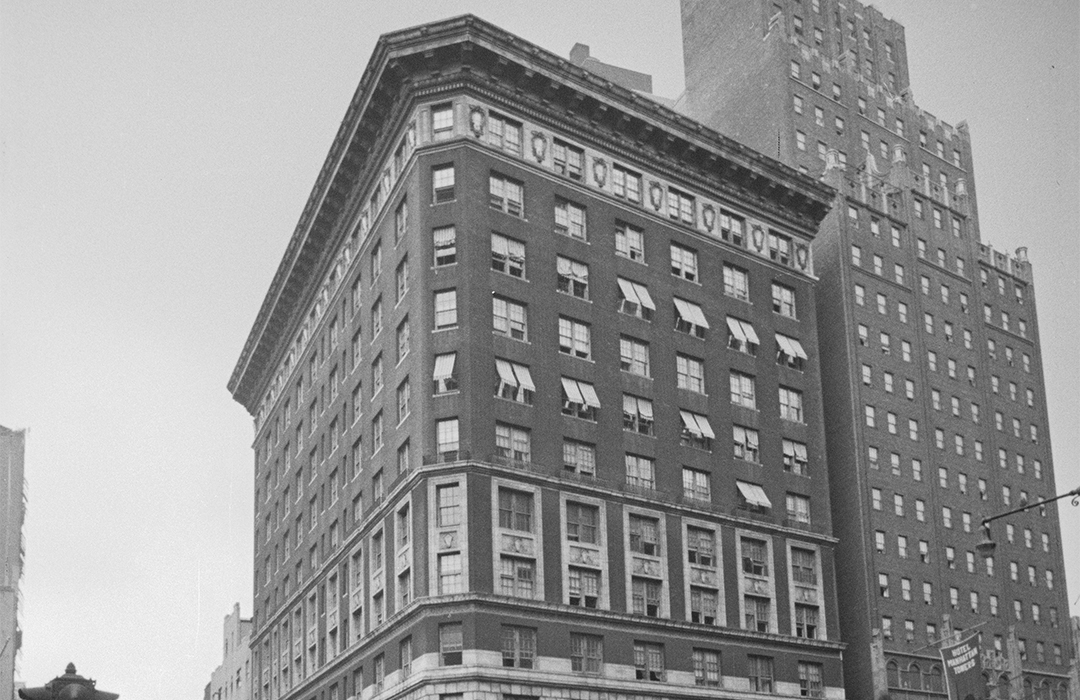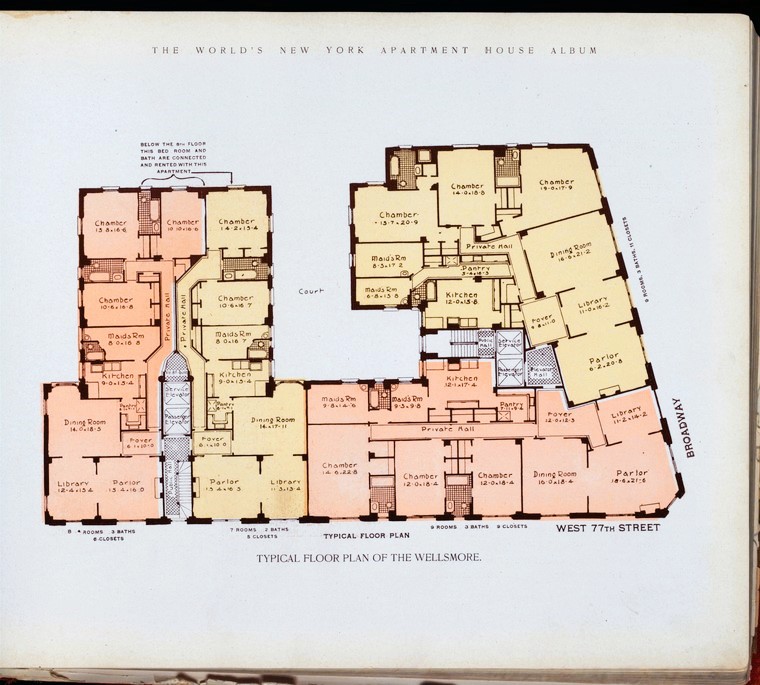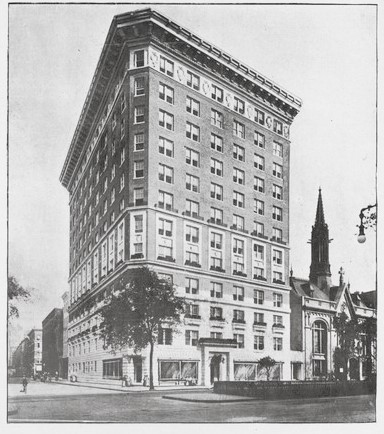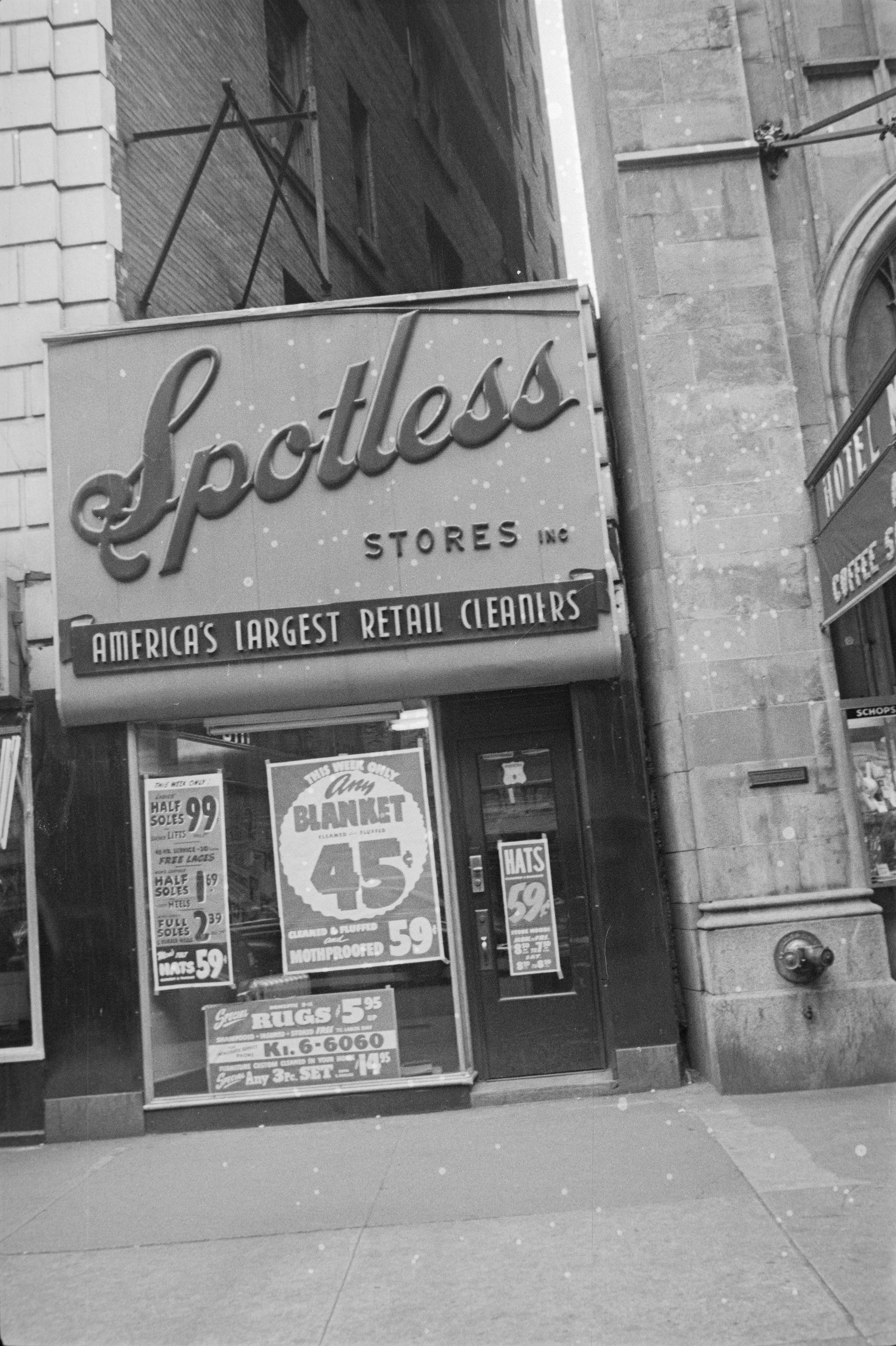
The Wellsmore
by Tom Miller
Brothers Leo S. and Alexander M. Bing were responsible for building some of Manhattan’s most lavish residential buildings in the first half of the 20th century. In the 1920’s and ‘30’s, their jazzy apartment buildings were the stuff of Fred Astaire movies. But that was still years away in 1909 when Bing & Bing hired the architectural firm of Janes & Leo to design a 12-story, 44-family apartment building on the southeast corner of Broadway and 77th Street.
Called The Wellsmore, it was completed in 1910 at a cost of $750,000 (more than $22 million in 2022). Janes & Leo’s Renaissance Revival featured a chamfered corner. Between the three-story rusticated limestone base and the stone-clad 12th floor were eight stories of brown brick trimmed in limestone. A projecting metal cornice crowned the structure. Unlike many of the high-class buildings rising along Upper Broadway, with their entrances tucked away on the side street, The Wellsmore’s residents entered directly on Broadway through a columned portico.
On August 7, 1910, The New York Times called it “one of the important additions to the high-class apartment houses of the west side.” The article said, “There are four apartments on a floor, arranged in suites of seven, eight, and nine rooms.” The World’s New York Apartment House Album added, “Mahogany and oak woodwork and French glass doors between parlor and dining room are some of the attractive features of the interior decorating of the apartments.”
There were commercial spaces along Broadway, one of which became the offices of Bing & Bing. Another was leased to the Rembrandt Galleries in August 1917. In reporting on the deal, The Sun reported, “The main store in Ghent has been stripped of many famous pictures, which will be on exhibition at the New York branch.”
The car skidded off the road and flipped upside down.
Among the early tenants were Paul Askenasy, his wife, and Elizabeth Dayton, Mrs. Askenasy’s daughter from a previous marriage. In May 1914, the 20-year-old Elizabeth quarreled with her stepfather and stormed out of their Wellsmore apartment to live with her aunt and uncle in the Bronx. It proved to be a fatal decision. On November 12, 1914, Elizabeth and two girlfriends went skating at the St. Nicolas Skating Rink on West 66th Street. They met 25-year-old William Roche who introduced himself and took them to Healy’s restaurant at 66th Street and Columbus Avenue around 6:00. There they ran into a friend of Roche, Joseph F. McGuire, a 22-year-old. The Evening World said McGuire, “recently was graduated from one of the big colleges and inherited a lot of money from his father.”
The newspaper said, “After dinner at Healey’s the party piled into McGuire’s car and motored down to Reisenweber’s in Columbus Circle. There they tangoed until the place closed up at 2 o’clock this morning.” McGuire and Roche then suggested they visit a roadhouse, and they drove up to the Woodmansten Inn near New Rochelle. The Evening World reported, “The party tangoed there until 7 o’clock this morning, when the girls decided they would better go home.” Elizabeth Dayton would never make it there.
McGuire took a curve on the Pelham Parkway at full speed. The car skidded off the road and flipped upside down. Elizabeth’s two friends and Roche were thrown out of the car, but McGuire and Elizabeth were “buried under it,” according to the article. Together, a group of employees from the Hunter’s Island Inn rolled the automobile off them. McGuire, “bruised, frightened and remorseful crawled out.” Elizabeth was dead.
The Askenasys rushed to the scene in a taxicab. Elizabeth’s mother fainted when she saw the body. On being revived, she fainted again. Askenasy arranged to have the body brought back to The Wellsmore apartment.
Living here at the time was Andre Bustanoby, his wife, and five children. He was deemed by The Evening Post to be “one of the best known restauranteurs of this city.” He and his brothers, Pierre, Louis, and Jacques, had opened the famous Café des Beaux Arts in 1901. By now Pierre and Louis were retired, and Andre and Pierre also ran Bustanoby’s on 39th Street and the renowned Louis Martin restaurant on Broadway and 60th Street. In February 1916 Andre Bustanoby was afflicted with a bizarre medical condition. The New York Press reported, “An abscess developed in his brain, and an operation was necessary.” Soon after the operation, he developed pneumonia, and he died at the age of 44 in his apartment on February 10.
Residents of The Wellsmore lived here only during the winter social season. Wealthy New Yorkers spent their summers at their country homes or fashionable resorts. The Van Wezel family’s country home was near Central Valley, New York, and there they had a hunting dog named Prince. The Chester News wrote on September 7, 1917, “A rabbit hunter, possessing unusual intelligence, is the way Mrs. Van Wezel describes him. At present he is having the time of his young life…but duty calls, and Prince is ready.”
“Thousands of dogs already are aiding the belligerents in sentry duty, field, and Red Cross work.”
That duty was World War I. Louis Van Wezel was already in Europe, a lieutenant with the Army. The article said, “The first dog to volunteer for service in the Canine Corps of the United States army registered on Wednesday and expressed a desire to go to the front immediately.” Mrs. Van Wezel had read dispatches released from Washington which said in part that “dogs can render indispensable service to the army and the Red Cross. Thousands of dogs already are aiding the belligerents in sentry duty, field, and Red Cross work.”
On December 21 that year, Edmund Schmoll, an importer, and dealer in furs and hides, died in his apartment at the age of 59. He left an estate valued at $20.5 million by today’s standards. His wife, Emma, received half, the other half being divided equally among their three children. The Sun noted on June 3, 1919, “All the beneficiaries live in 2170 Broadway.”
On October 6, 1939, The New York Times reported that The Wellsmore had been sold. “The buyer intends to modernize it,” said the article. “Modernize” was, perhaps, a delicate and misleading term. The once opulent building was converted to single occupancy rooms. Its days of servants and summer homes had ended.
In the 1990’s Roxy’s Bistro was in 2170 Broadway. For New Year’s Eve 1990, it presented “Murder at the Bistro,” described by Newsday as “a black comedy created and acted by the Bristo’s staff, plus four-course, prix-fixe dinner.” Zen Palate, an Asian vegetarian restaurant, opened in 1995 and would remain for years.
Major change came when a renovation, begun in 2000, transformed The Wellsmore into the Arthouse Hotel. Although the entrance was moved around the corner where the former ‘trade entrance” was located and the Broadway entrance closed off, the hotel still uses the Broadway address.
Tom Miller is a social historian and blogger at daytoninmanhattan.blogspot.com
Building Database
Keep Exploring
Be a part of history!
Think Local First to support the businesses currently at 2170 Broadway





